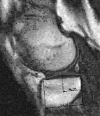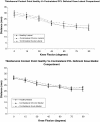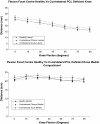Sagittal plane articulation of the contralateral knee of subjects with posterior cruciate ligament deficiency: an observational study
- PMID: 22433125
- PMCID: PMC3349498
- DOI: 10.1186/1749-799X-7-12
Sagittal plane articulation of the contralateral knee of subjects with posterior cruciate ligament deficiency: an observational study
Abstract
Background: The aim of the present study was to compare the in vivo articulation of the healthy knee to the contralateral knee of subjects with acute and chronic PCL injuries.
Methods: Magnetic resonance was used to generate sagittal images of 10 healthy knees and 10 knees with isolated PCL injuries (5 acute and 5 chronic). The subjects performed a supine leg press against a 150 N load. Images were generated at 15 degree intervals as the knee flexed from 0 to 90 degrees. The tibiofemoral contact (TFC), and the centre of the femoral condyle (as defined by the flexion facet centre (FFC)), were measured from the posterior tibial cortex.
Results: There was no significant difference in the TFC and FFC between the healthy knee and contralateral knee of subjects with acute and chronic PCL injuries in the medial and lateral compartments of the knee.
Conclusions: The findings of this study suggest there is no predisposing articulation abnormality to PCL injury, in the setting of chronic injury the contralateral knee does not modify its articulation profile and the contralateral knee can be used as a valid control when evaluating the articulation of the PCL deficient knee.
Figures





Similar articles
-
Magnetic resonance imaging study of alteration of tibiofemoral joint articulation after posterior cruciate ligament injury.Knee. 2012 Jan;19(1):60-4. doi: 10.1016/j.knee.2010.11.010. Epub 2011 Jan 12. Knee. 2012. PMID: 21232963
-
The effect of posterior cruciate ligament deficiency on knee kinematics.Am J Sports Med. 2004 Dec;32(8):1915-22. doi: 10.1177/0363546504265005. Am J Sports Med. 2004. PMID: 15572321
-
Effect of posterior cruciate ligament deficiency on in vivo translation and rotation of the knee during weightbearing flexion.Am J Sports Med. 2008 Mar;36(3):474-9. doi: 10.1177/0363546507310075. Epub 2007 Dec 5. Am J Sports Med. 2008. PMID: 18057390
-
A review of the anatomical, biomechanical and kinematic findings of posterior cruciate ligament injury with respect to non-operative management.Knee. 2012 Dec;19(6):738-45. doi: 10.1016/j.knee.2012.09.005. Epub 2012 Sep 28. Knee. 2012. PMID: 23022245 Review.
-
Biomechanical analysis of tibial torque and knee flexion angle: implications for understanding knee injury.Sports Med. 2006;36(8):635-41. doi: 10.2165/00007256-200636080-00001. Sports Med. 2006. PMID: 16869706 Review.
Cited by
-
Intercondylar notch volume in patients with posterior cruciate ligament tears and tibial avulsion injuries: a study applying computed tomography.J Orthop Surg Res. 2022 Dec 23;17(1):560. doi: 10.1186/s13018-022-03451-4. J Orthop Surg Res. 2022. PMID: 36550563 Free PMC article.
References
MeSH terms
LinkOut - more resources
Full Text Sources
Medical

